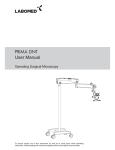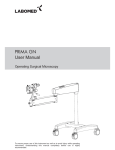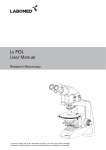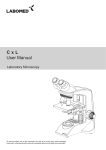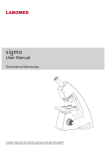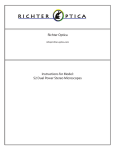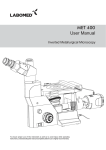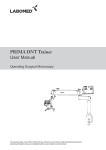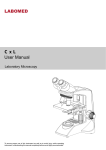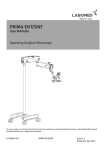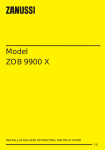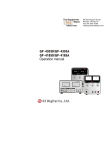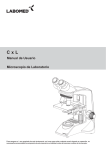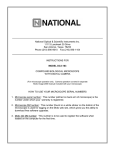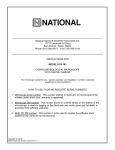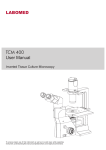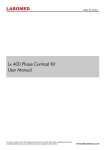Download - Labo America, Inc.
Transcript
R Prima OPH User Manual Ophthalmic Microscopy To ensure proper use of this instrument as well as to avoid injury while operating instrument, understanding this manual completely before use is highly recommended. CONTENTS 1 INTRODUCTION 1 2 SAFETY INSTRUCTIONS 2 3 SPECIAL INSTRUCTIONS 3 4 UNPACKING 4 5 DESCRIPTION OF PARTS 5 6 SYSTEM DIAGRAM 6 7 INSTRUCTIONS 8 ELECTRICAL CONNECTIONS 10 9 CONTROLS 11 7-10 10 INSTRUCTIONS FOR USING THE MICROSCOPE 12 10.1 SETTING UP MICROSCOPE 12 10.2 SETTING UP MAGNIFICATION 12 11 HOW TO FOCUS THE OBJECT 13 12 CHANGING THE OBJECTIVES AND EYEPIECES 13 13 ADJUSTMENT OF TENSION WHILE USING ACCESSORIES 13 14 DISINFECTION AND STERILIZATION 13 15 CLEANING AND SERVICING 14 16 TROUBLE SHOOTING TABLE 15-16 17 TECHNICAL SPECIFICATION 17-18 1 INTRODUCTION The LABOMED Prima OPH is an Ophthalmic microscope, which is adaptable for different surgical needs without compromise to performance. The microscope provides extremely high optical image quality, good depth of focus and wide field of view for precise surgery. Illumination control, inbuilt tilt, adjustment of the observation head help to reduce the surgeon’s work fatigue and allow comfortable use over long period. Salient features of this Microscope are: 1. The observation head can easily be positioned with the help of suspension arm . 2. An advanced 5-step magnification changer allows an optimal magnification for a particular surgery from five different magnifications. 3. Auto home position for X-Y movement can be done by touch of a button. 4. Cold light illumination with a high intensity 150W Halogen lamp is provided using a fiber optic guide for proper illumination. The illumination is further adjustable up to its most suitable brightness using intensity control knob suitably located at the suspension arm, and is easily approachable to the surgeon. 5. The simple lamp changing mechanism allows to change lamp quickly when the lamp in use blows during operation. 6. The power supply to the lamp automatically goes OFF when the suspension arm is raised to its top most position. 7. When the microscope is not in use, the suspension arm can be folded over the main body to store it compactly. 8. Rigid H-form base with castor wheels provides greater stability as well as mobility to the instrument. 1 2 SAFETY INSTRUCTIONS Prima OPH 1. This microscope is manufactured according to the safety norms as per CE regulation and FDA. 2. This microscope is intended for use only as prescribed in this manual. 3. Servicing and repairs are allowed through authorized persons only. 4. Replace burnt out fuses by live fuses of the same type only (rated voltage, rated current, switch – off characteristics.) 5. Use mains plug and mains socket both with protective earth conductors only. 6. Do not use force while fixing cable connections. If the male and female parts do not readily connect, make sure that they are appropriate for one another. If any of the connectors are damaged. Please contact the representative. 7. Make sure that inlets and outlets of ventilation system for cooling the housing are open (not covered). 8. The microscope is built for use in dry rooms only. Take care that no fluids enter the microscope components. Do not place any fluid-filled container on top of instrument. 9. Microscope is protected against overheating through a thermal cut-off. 10. The manufacturer will not accept any liability for damage caused by unauthorized persons tampering with the instrument; this will also forfeit any rights to claim warranty. 11. It is recommended to use the instrument only with the accessories supplied. In case you wish to use other accessory, make sure that LABOMED has certified that its use will not impair the safety of instrument. Very important : For identification, service people must know the serial number of the microscope. Intended Use: The Prima OPH is a universal instrument for operative and diagnostic medical use. It is useful for optimal illumination and magnification of the attendance area with the possibility of: 1. Manual variations of magnification 2. Motorized focusing (Z-axis) through foot control 3. Motorized centering of attendance area in XY directions through a Joystick provided on the foot control (applicable to the suitable model) 2 3 SPECIAL INSTRUCTIONS 3.1 Before every use and after re-equipping the instrument 1. Check all Electrical connections. 2. Attach sterilized covers, panels or caps which have been re-moved or opened. 3. Pay special attention to labels on the instrument, such as caution label, warning triangles with exclamation marks or notes. 4. Do not cover nay ventilation openings. 3.2 When instrument is in use 1. Avoid looking directly into the light source, microscope objectives lens or light guide. 2. When the illumination is on, the light guide must be connected at both ends. Otherwise there is a risk of fire or burn injuries. 3. Any kind of radiations has a detrimental effect on biological tissue. This also applies to illuminating the surgical field, therefore adjust the brightness and duration of illumination on the surgical field to the absolute minimum required. 4. Adjust tension of suspension arm as per convenience. 3.3 After every use of the instrument 3 1. Switch off the Mains sullpy to the instrument. 2. When the microscope is not in use, the suspension arm can be folded over the main body for compact storage. 4 UNPACKING Prima OPH The appliance is delivered in sub-assembled groups along with one set of Installation Kit and one instruction / service manual. Please check following at the time of unpacking 1. Mobile supporting base with castor wheels, or as ordered 2. Column, as ordered 3. Illumination Box 4. Swivel arm and Suspension arm assembly 5. Cover for swivel arm 6. X-Y motorized coupling; if ordered 7. Z-axis motorized focusing attachment with magnichanger assembly 8. Foot controls, (with Joystick in case of XY model) 9. Observation Head 10. Paired Eye Pieces; as ordered 11. Power Cord 12. Set of sterilizable caps 13. Installation Kit a) Allen Wrench 3.00mm b) Allen Wrench 4.00mm c) Allen Wrench 5.00mm d) Allen Wrench 6.00mm e) Allen Wrench 8.00mm f) Spanner-12/ 13mm 12. Instruction cum Operating Manual / Service Manual 4 5 DESCRIPTION OF PARTS 14 13 12 9 11 15 17 7 23 10 8 5 2 18 1 14 13 12 3 19 15 17 16 23 20 11 9 7 8 10 2 1 6 18 5 21 3 19 20 21 1. Observation Head 2. Eyepieces 3. CMO - Common Main Objective 4. Fibre Optic Cable 5. X-Y Coupling 6. Z axis coupling 7. Intensity Control Knob 8. Coupling Locking Knob 9. Up/Down Movement Control Knob 10. Cable Cover 11. Suspension Arm 12. Suspension Arm Locking Knob 5 13. Swivel Arm 14. Swivel Arm Locking Knob 15. Illumination Box 16. Lamp Changing Knob 17. On/Off switch for Foot Control 18. Connectors 19. Pillar 20. Moveable Base 21. Castor Wheel with Lock 22. Foot Control with Joystick 23. Tension Adjustment 6 SYSTEM DIAGRAM A616500-811 613800-815 Ad- 613400-820 612086-600 6122012 1271094 A612086-400 6136000-900 6133176-00 6135000-800 6133201-000 6134105-102 6122016 6122020 A6122015-800 6134105 6134100-800 6133251-000 6135000-809 6135000-909 6137300 6165000-817 6137200 6137500 6137100 6 7 INSTRUCTIONS Prima OPH 7.1 Pull out the base from the wooden pallet by removing two nuts with the help of spanner provided. 7.2 Remove allen screws from bottom side of the pillar. 7.3 Put the pillar on the base and align it with the pillar guide pin (A). After aligning the screw holes with the guiding holes on base, fix the screws removed in Fig 2 using allen wrench 8mm. Fig.2 and 3. Fig. 2 7.4 Remove safety cap from topside of the pillar. 7.5 Place swivel arm on the pillar by sliding in the groove and rotate the suspension arm by 90° as shown in Fig.4. Fig. 3 Fig. 4 7 Prima OPH 7.6 Firmly tight the safety lock screw provided on the suspension arm by using allen wrench 3mm. See fig 5. 7.7 Remove four allen screws from the illumination box before mounting it on pillar. 7.8 Fix the illumination box on the pillar only after having the connectors passed through the hole provided on Fig. 5 the H- block. Refer to fig 6. 7.9 Secure the illumination box with four allen screws provided using wrench 5mm. See fig 7. 7.10 Connect two appropriate male female connectors provided for electrical connection. See fig 8. Do not pull the cables too much to join the connector’s. Additional force can damage wire connections. Fig. 6 A B Fig. 7 A Fig. 8 8 Prima OPH 7.11 Install the microscope coupling to the suspension arm C prior to installing the head and eyepieces. Before installing, loosen the coupling locking knob (A) and safety position screw (B).Slide in the carrier shaft to B A the suspension arm and screw it with locking nut. Secure the locking knob (A) and safety position screw (C). Fig. 9 7.12 Remove the caution label from the suspension arm. Unscrew safety nut (A) from the carrier and guide the B shaft smoothly into the bush of suspension arm as shown in Fig. 9 A 7.13 Remove the cable cover by unscrewing two allen screws provided at the lower side. Run the fibre optic cable and the cable meant for intensity control knob and XYZ control through the tray. Fig. 10 7.14 Set the cable cover on the suspension arm by aligning the guide screw with the groove provided on the cover by using allen wrench 3mm.(Fig. 12) 7.15 Remove the swivel arm locking knobs A & B. Remove the self tapping screws fixed on the top and bottom side of cover for swivel arm. Fix these panels on swivel arm and fix back the screws removed earlier. Make sure that wire for Fibre optic is passed through while Fig. 11 fixing the panels. See fig 11 and 12.. B A Fig. 12 9 Prima OPH 7.19 Assemble fibre optic cable into the hole provided at the backside of magnichanger assembly by gently pushing it in, as shown in fig 13. A click sound will confirm correct position. 7.20 Plug in the wire for foot control into the illumination box. See fig 14. Fig. 13 Fig. 14 8 Electrical Connections 8.1 Adjusting mains Voltage: Connect the power cable to the AC inlet socket provided on the illumination box and check the voltage settings at the voltage selector switch. The line voltage of the electrical system is set in the factory the rated line voltage of the country of destination which must be either 110V or 220V AC. The line voltage available at the site of installation must lie within the admissible voltage range. If this is not the case you must not operate the system. 8.2 Connections of Various Controls: Fig. 15 8.2.1 Connect 7 pin connector from X-Y coupling assembly to terminal of electrical box. 8.2.2 Connect 4 pin connector from Z-axis motorized control assembly to terminal of electrical box. 8.2.3 Connect 12-pin connector from foot control to terminal of electrical box. This completes your electrical connections. 10 Prima OPH 9 Controls 9.1 ON/OFF Switch 9.1 ON/OFF switch It is located on the Right hand side of illumination box “1” indicates ‘ON’ position of microscope. At ‘ON’ position green LED glows and cooling fan starts running. Keep the intensity control knob at minimum level before changing / replacing the lamp. To save burning life of lamp, switch OFF the appliance if the microscope is not in use for longer time. 9.2 Lamp changing knob It is located on the right hand side of illumination box. If lamp blows off during the use of microscope, the Prima OPH is provided with a spare lamp. Lamp changing knob connects to the Lamp II for smooth running of the operation by turning it anti-clockwise. 1 3 2 Fig. 16 9.3 Intensity control knob It is located on the suspension arm. Brightness of field of view can be adjusted as per user comfort using intensity control knob. 9.4 Brakes Locks the stand from unwanted movement by pressing down the two brakes provided on caster wheels. To unlock press upper portion of brake. See Figure 9. 9.5 Swivel arm locking knob This knob helps you to lock the movement of swivel arm at the desired position after initial focusing of the attendance area by turning it clockwise. 9.6 Suspension Arm locking knob This knob locks the movement of suspension arm at any desired position by turning it clockwise. 9.7 Coupling locking knob This knob is located on the suspension arm and helps to lock the position of observation head at any desired point by turning it clockwise. 9.8 Up / Down Movement Control Knob Locks the UP/Down movement of Suspension arm at a desired position after initial focusing of the attendance area. Fine focusing is done using F.O.V. 11 Fig. 17 10 INSTRUCTIONS FOR USING THE MICROSCOPE 10.1 Setting up of Microscope: 10.1.1Lock all the brakes on base wheels after setting up of microscope on the attendance area for stability. 10.1.2 Adjust tension on suspension arm using tension adjustment screw as per your convenience by turning the knob clock wise or anti-clock wise. 10.1.3 Lock the Up & Down movement of suspension arm using locking knob after coarse focusing of the attendance area. 10.1.4 Adjust the eye distance as per IPD scale according to your convenience. Fig. 18 10.2 Setting up of magnification (Ref. 18) 1. Adjust to highest magnification with one of the rotating knobs provided at magnification changer. 2. Fine focusing is done through F.O.V. knob 3. Absolute centering of observation area in field of view can be done by manual handle(21c) 4. Make sure that the magnification changer is engaged in the index point at the click stop position. 5. Use filter changing knob (18d) to change filters. 12 11 How to focus the object 1. Adjust both the eyepieces to ‘0’ diopter adjustment. 2. Adjust IPD of the observation head using IPD scale. 3. Bring highest magnification factor in the click stop position using one of the knobs provided at the magnichanger unit. By doing so observation area will remain parfocalized in all magnifications. 4. Fine focusing is done by using foot control by pressing on up and down paddles. Fig. 19 12 Changing the objectives/ eyepieces 1. The objectives can be taken out by rotating it in anticlockwise direction. It can be threated in by rotating in clockwise direction. 2. To install the Eyepieces, insert in the Eyetubes of observation head. 3. A range of objectives/eyepieces can be selected by choice. Fig. 20 13 Adjustment of Tension while using Accessories After Supplementary accessories are mounted, the additional load of suspension arm must be compensated by adjusting tension on tension control screw provided on suspension arm by moving it clock wise or anticlockwise. Fig. 21 14 Disinfection and Sterilization For Diagnosis: Moisten smooth cotton with antiseptic fluid (for example Sagrotan – P); when required , clean often touched parts, like rotating knobs, handles and so on. After surgery:Sterilizable polymer covers are provided on every part that require to be touched during operation. Sterilize them after every use of the instrument. 13 15 15.1 Prima ENT CLEANING AND SERVICING Cleaning of optical surfaces: Remove coarse dirt particle with a clean dry air from optics outer surfaces (Objectives, Eyepieces). Moisten smooth cotton cloth with lens cleaning agent and wipe on the lens surface gently starting from the middle of the lens to the outer edge. 15.2 Cleaning of mechanical surfaces: All mechanical surfaces of the equipment can be cleaned by wiping with a moist cloth. Don’t use any aggressive or abrasive cleaning agents. Any household dish washing fluid can be used for cleaning residue. 15.3 Servicing: Service whenever required, inform after-sale service. 14 16 Prima OPH TROUBLESHOOTING TABLE Problem No Illumination at all Insufficient Illumination Halogen lamp in the illumination system remains dark, and fan is running. Halogen lamp goes constantly off and on during operation. 15 Possible Cause Remedy Power cable not plugged Plug in power cable. Power switch not pressed Press power switch Defective instruments fuse Change instrument fuse Defective power cable Change power cable Line power failure Contact in-house Techician Failure of suspension system electronics Contact service dept. Light guide not properly inserted in lamp or microscope. Insert light guide to the maximum intensity. Brightness level set too low Adjust brightness using the brightness control knob. Light guide not properly inserted in lamp or microscope. Insert light guide to the maximum illumination Defective light guide (illumination not uniform) Chance light guide. Knob for brightness control not operated Turn the knob clock wise Lamp module has no contact. Insert lamp module properly. Defective halogen lamp. Switch to backup lamp. Ventillation slots are covered or contaminated Ventillation slots must be clear, clean them if necessary. Prima OPH Problem Possible Cause Remedy Thermal cut-off in lamp housing is contaminated. Clean thermal cut-off with a dry brush; blow it clean, if necessary Defective fan. Failure of system electronics. Contact service dept. Illuminate surgical field using an Or illuminator. Contact service dept. Up & Down motion of screw on suspension system too stiff Friction adjustment screw on suspension system tightened too firmly. Loosen friction adjustment screw on suspension system as require Microscope Unstable Brakes on wheels not used. Use Brakes. No image visible in field of view. Magnichanger is not indexed properly. Index magnichanger properly. 16 17 Prima OPH SPECIFICATIONS Technical Data (Specifications) Binocular tubes 45° inclined Eyepieces WF 10x/16mm with eye guards; optional WF 12.5x/16mm; WF 16x/16mm Apochromatic Magnichanger 0.4x, 0.6x, 1.0x, 1.6x & 2.5x Objective f=200, motorized fine focus Light source 15V/150W halogen, twin lamp Built-in filters Green & Blue Vertical movement of arm 600 mm Microscope carriers XY coupling or basic Ophthalmic carrier (motorized fine focus) Accessories Assistant Binocular attachment, iVu OP Beam splitter integrated digital camera Module; Double Beam splitter; 0°-210° inclinable ergo tube Type: Floor stand Base (Dimensions): 775mm width 762mm length 17 Stand Height: 1676mm Weight of complete microscope: 72 Kg. Approx. Elevation Stroke: 600mm Stand Height in Horizontal Position: 1100mm Field of illumination with F.O.V. f=200mm objective: Ø 70mm Dimensions 18 www.laboamerica.com Our policy is one of continuous development. Labo America, Inc., reserves the right to change design and specifications without prior notice. Labo America Inc. 920 Auburn Court Fremont CA 94538 U.S.A. Telephone: 510 445 1257 Fax: 510 445 1317 [email protected] LABOMED and Prima OPH are registered trademarks of Labo America, Inc. With a policy of continuous development, Labo America, Inc. reserves the right to change design and specifications without prior notice. © 2010 Labo America, Inc. | 6135000-990A 02-2010 ISO 9001 : 2008 File No. A9020






















